The Nature Diary
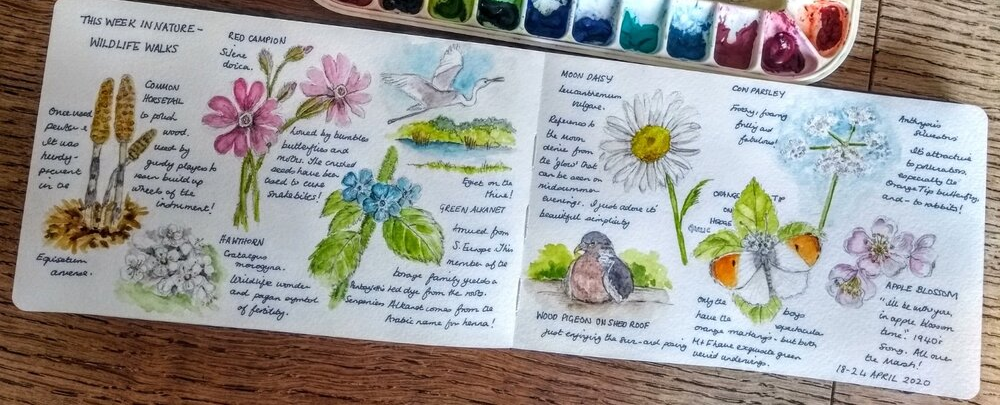
Many of you, I know, keep a nature diary in some form and what I am trying to do here is to provide a way of collating all this wonderful information into one place.
2024
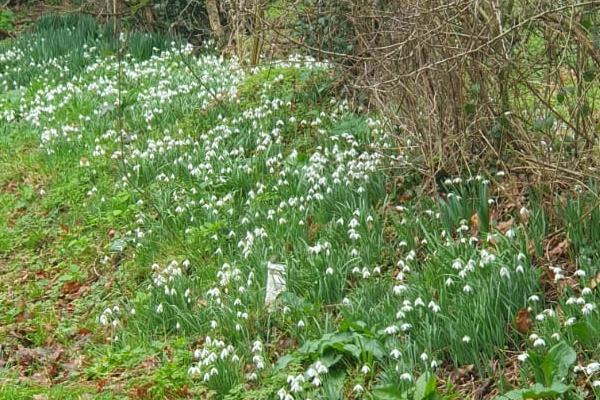
Snow Drops
I'm not sure where these came from originally, but what started as a few solitary bulbs a few years ago, has now become a substantial carpet of white that you see this year and it gets better year by year. The first true indication that spring is on it's way this year was by the end of January when the first few white topped green shoots showed through the dead oak leaves under the hedge. By 15th Feb tt was just about resplendent in it'slate winter carpet of white flowers
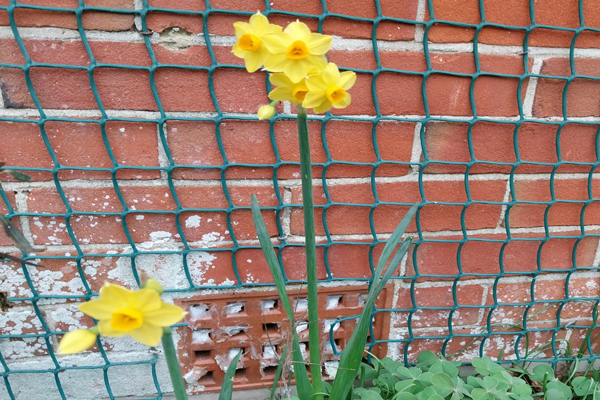
Daffodils
The daffodils this year are just dtarting to show the occasional display of swollen buds giving the hint of what may follow. The flowers this year are proving to be a little confused by the eratic temperatures as spring approaches,and whilst the rest of the garden is still just swollen buds at best, these little beauties are really getting into the spirit of spring.
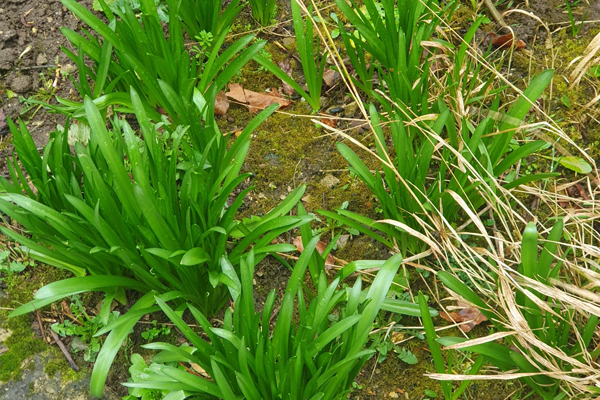
Blue Bells
I was privileged to have spent many years working in the private woodlands of my native Dorset, spending my spring times surrounded by carpets of the deepest blues of these bluebells. I once brought home a small handfull of these bulbs (you are not supposed to) and gave them to my Dad to plant in his garden. Something he and I had spent many hours working on. We sadly had lost him to dementia about five years ago. So I rescued a small clump of the bluebells from his garden after he had passed, and planted them in my own garden. They had since been 'ok' where I had put them, but this year they had sudenly flourished until last year. I am hoping that this year will have them prosper more than last year.
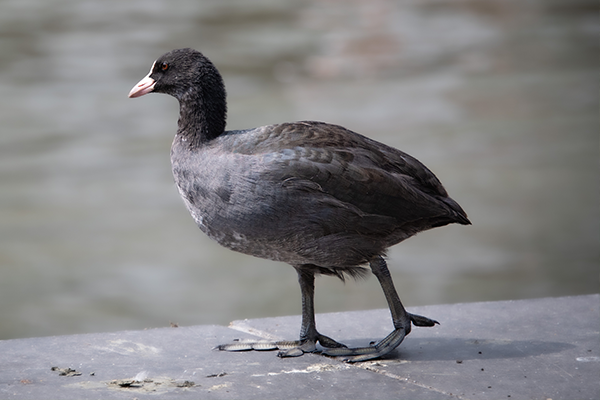
Cootes
I have yet to catch a picture of the young chick which seems to be inhabiting the village pond. It is too old to be one of this years chicks but certainly too young to be one of last years chicks from a family of chicks from the normal timescale. It is a little toquick to be photographed so for now I have shown a stock image for illustration.
2023
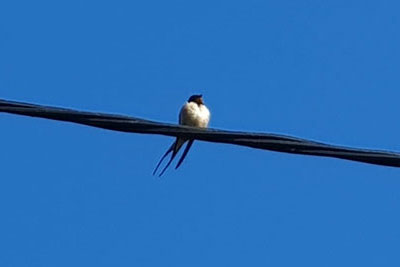
Swallows
After last night's storm, today, 22nd March 2023, we awoke to a beautiful blue sky and sunny day. Sat on the power cables outside my office was this little visitor with a great deal on his mind ad intent on announcing to the world of his arrival. As far as I am aware this year is by far the earliest visit by these absolute marvels of stamina and inuitive mavigation. I cannot help but wonder at the size of these beautiful creatures and the skill they demonstrate in finding their way, firstly to their southern hemisphere home in South Africa. Somewhere they have never visited before and would have no knowledge of it'e very existence, and secondly, the skill in finding their way back to the very area they had been born in for next summer.
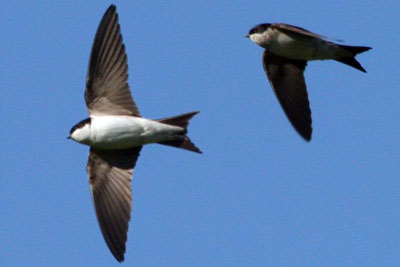
House Martins
Today, Holy Saturday, 8th April 2023, a little pair or House Martins joined me on Manor Farm. We have been saved the storms which had battled the Swallows on their journey from Africa. Not sure when they put in theor first appearance , but I first noticed them at about 10:00 am and byt that time they were already chasing and chattering at each other. Clearly none the worse for their arduous journey from their winter grounds. So many adventures since last they saw our countryside. Whatever adventures they have encountered since last I saw my little friends here, I am glad they are once again using the garage beside my office as their nesting shelter as another brood of chicks start the whole cycle over again.

Swift
The swifts put in an appearance in May this yer. I am reliably informed by Laurie Waite, they were around Compton Farm and are usually about four in number, although they do come and go.
With luck these plucky aviators will sucessfuly breed this year and hopefully next year we may see a stronger flock
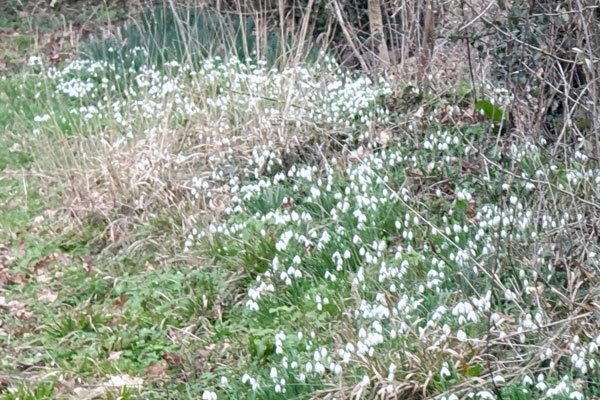
Snow Drops
I'm not sure where these came from originally, but what started as a few solitary bulbs, has now become a substantial carpet of white. The first true indication that spring is on it's way! But it proved to be the case this year, winter had yet to fully finish her wintry strangle hold on our countryside and gardens as night-time temperatures of nearly -10℃ followed through until the end of January and into February.
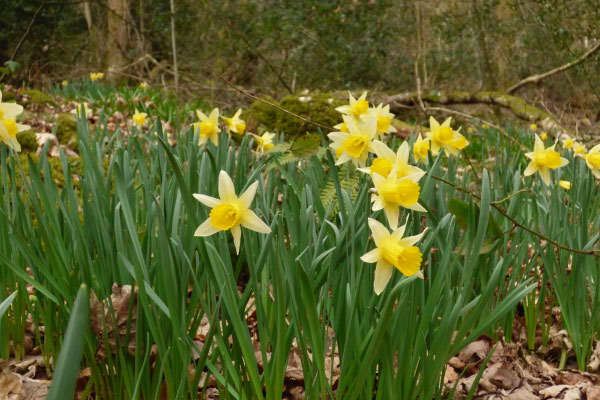
Daffodils
The scent of our woodland daffodils is quite intoxicating and this year proved to be no different. The UK is home to some of the most delicate examples of our native daffodil. These little delights were seen on 22nd February although they may well have been around for a little while before this.
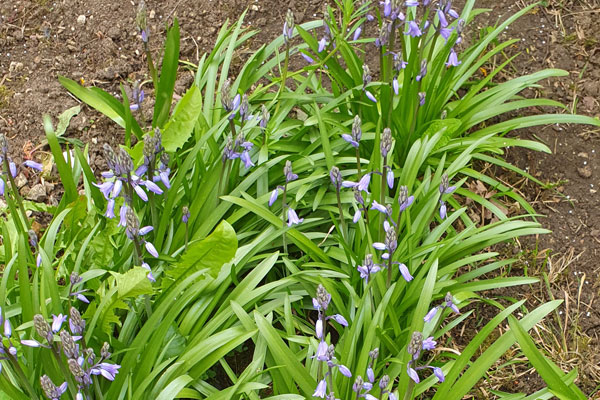
Blue Bells
I was privileged to have spent many years working in the private woodlands of my native Dorset, spending my spring times surrounded by carpets of the deepest blues of these bluebells. I once brought home a small handfull of these bulbs (you are not supposed to) and gave them to my Dad to plant in his garden. Something he and I had spent many hours working on. We sadly had lost him to dementia about five years ago. So I rescued a small clump of the bluebells from his garden after he had passed, and planted them in my own garden. They had since been 'ok' where I had put them, but this year they had sudenly flourished and about a week ago (13th April) they burst into bloom. I shall be watching them for even greater efforts next year.
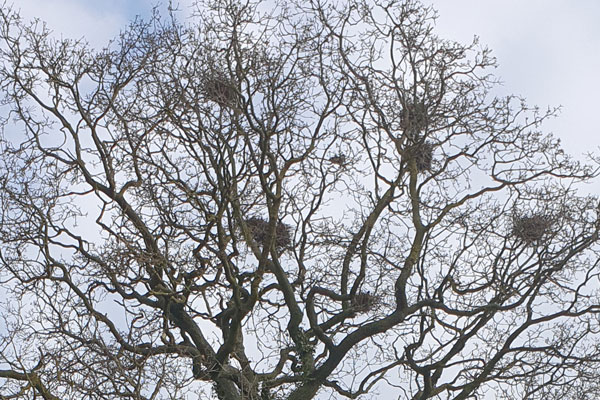
Noisy Neighbours
In recent years the size and associated volume of the rookery surrounding our cottage has increased considerably and last year was filling all the perches in many trees. After several storms dislodged many of the nests the rookery was indeed much smaller and quieter than in previous years.
As spring slowly brought the countryside back to life a depleted rookery started to come back to life again. They are smaller in number and quieter than before but I feel sure that by the time this season is over the numbers will have replenished to some extent. But for now it is quite pleasent to hear the other birdlife getting a word in edgeways.
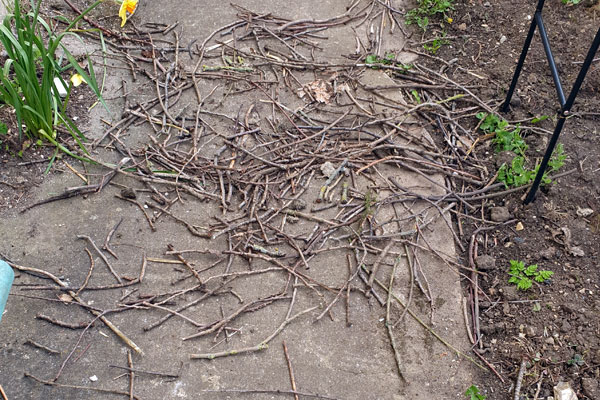
Littering Neighbours
In recent years we have played host to several ravens and their offspring in the loft above our bed. It is nest-building time and as the adults return with another stick for their nest they first land on the fence as they eye up the stick and also the hole they need to get the stick through. This then needs to be taken closer and weighed up again and then dropped to the floor as it won't fit through the hole. Thats fine but if they just turned and took one end of the twig through it would fit.In the meantime the heap of sticks gets larger and they sit is the entrance to the loft through the hole and curse us as we walk past.
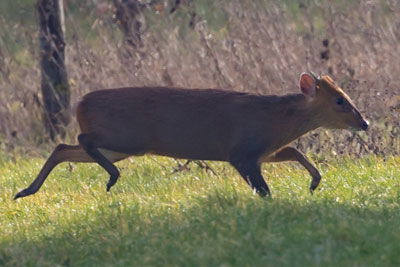
Deer
We were blessed, in past years, with several native deer species here in the UK. From our smallest native, the roe deer, the sitka, the fallow deer through to the mighty red deer
Increasingly common, the muntjac deer was introduced into the UK from China, in the 20th century, to Woburn Park. It has gained a stronghold in southeast England, where it can cause damage to our woods through browsing, but is increasingly common in our fields and woodland here in Wiltshire.
I was introduced to this little beauty locally recently. As much to his surprise as to mine, as he sunned hmself in the shorter grass of the fields after the first cut of hay or silage this year.
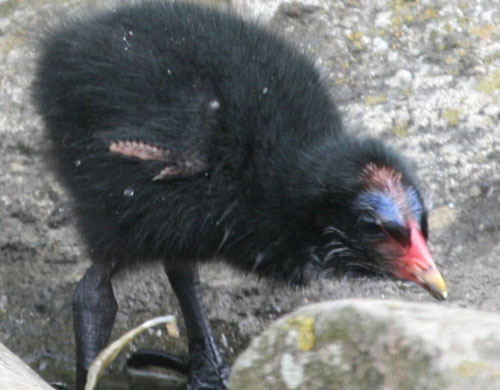
Moorhen
This little beauty made me a happy man this week. We always used to have two moorhen adults living in the village pond. Each year they produce a couple of chicks and then during the mid summer months one of the adults would fall 'fowl' of the traffic that comes though the village at breakneck speed. Quite remarkably, within days he (or she) has found a replacement parent. And life goes on. In recent years they have been conspicuous by their absence. Yesterday many in the village were the victims of a day-long power cut due to downed power lines and I spent half an hour talking to the Wessex Water men whe were setting up a generator to keep the pumps down by the pond to keep the waste water flowing away from the village to the treatment works
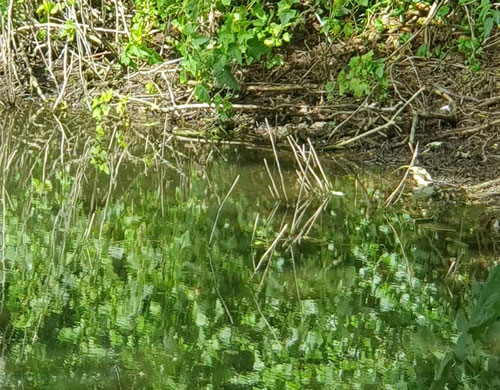
Moorhens (cont..)
The image to the left is just a stock iage of a moorhen chick for illustration, but I have taken the above image of the chicks near the pond. Yes, there are two moorhen chicks in this picture and no, I couldn't see them either. But yes they are most definitely there. Nature is wonderful at hiding the vulnerable!
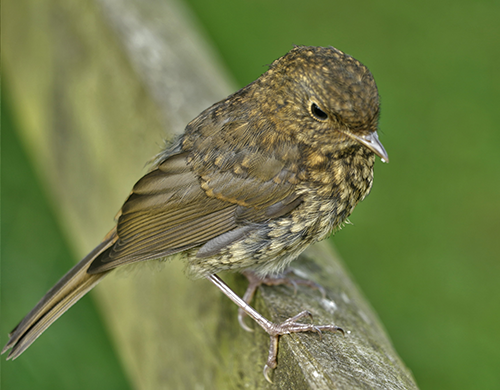
Robin Juveniles
After heavy rain on many of the recent mornings it was nice to see a promising morning weather as I drank my early morning cup of tea. The best cup of the day!
This little fella was sat, perhaps hoping for his own morning tea, but settled instead for that little droplet on the end of his beak. He would have left his nest at about 14 days old but would have stayed locally to his parents for about three weeks. In May he would have moved awayfrom his natal site (up to a few miles). He will keep his speckled feathers, usually until late summer, when a partial mould will lose his speckled feathers and replace them with his traditional red breast. Robins are born without red breasts to avoid territorial clashes with other robins. Clashes of territory are the reason for up to 10 percent of deaths in adult robins in some populations. Anyway, it was nice to share my morning tea with him.
2020
Cuckoos
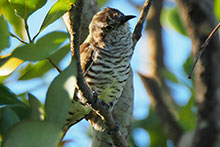 After many years absence, and then two years where those familiar calls had filled the summer skies I had dared to hope that the cuckoo is perhaps finding Compton Bassett a suitable place to lay its eggs once more? In 2018 a call was heard first on 2nd May but sadly last year had proved the reversal of the trend had in fact gone back to the recent pattern of a cuckoo-less sky
After many years absence, and then two years where those familiar calls had filled the summer skies I had dared to hope that the cuckoo is perhaps finding Compton Bassett a suitable place to lay its eggs once more? In 2018 a call was heard first on 2nd May but sadly last year had proved the reversal of the trend had in fact gone back to the recent pattern of a cuckoo-less sky
My fingers are crossed that they may just be late in their incredible journey and there may yet be more young from this iconic bird this summer. I can but hope!
Swifts Swallows and House Martins
 This year the first two brave pairs of swallows flew across Compton Bassett heading northwards on 5th April perhaps the earliest for many years.
This year the first two brave pairs of swallows flew across Compton Bassett heading northwards on 5th April perhaps the earliest for many years.
The house martins seemed to have sneaked in almost without recognition a week later. Although no-one seems to have noticed exactly when. They were just 'there' one morning.
It was then on 29th that five Swifts were spotted near Calne by Laurie Waite
This year they have all arrived safely and early.
Has anyone seen any Cuckoos? We seem to have lost some.
2017
Swallows and House Martins
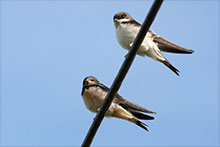 This year the arrival of the House Martins and the Swallows was first reported by John Reis on 5th April at The Manor and on the same day by Adrian Elmer at Manor Farm. This year they seemed to have arrived with the intention of staying in sufficient numbers to have started their summer breeding season straight away.
This year the arrival of the House Martins and the Swallows was first reported by John Reis on 5th April at The Manor and on the same day by Adrian Elmer at Manor Farm. This year they seemed to have arrived with the intention of staying in sufficient numbers to have started their summer breeding season straight away.
In past years their habit has always seemed to be to arrive and spend a few day before moving on for short while before returning to start their breeding season. But not so, it seems, this year.
Cuckoos
 The Cuckoo, apart from the fleeting glimpse last year, which may have been attributed more to a bird still on it's homeward leg of it's spring migration hasn't been seen (or heard) around these parts for many years but this year has taken up a more permanent residence in the Cumberwell region of the village. As was reported on 2nd May this year by Laurie Waite who lives in that part of the village.
The Cuckoo, apart from the fleeting glimpse last year, which may have been attributed more to a bird still on it's homeward leg of it's spring migration hasn't been seen (or heard) around these parts for many years but this year has taken up a more permanent residence in the Cumberwell region of the village. As was reported on 2nd May this year by Laurie Waite who lives in that part of the village.
Swifts
 These summer visitors have again graced us with their presence around the 24th of April, and have again visited my office with a quick trip around the inside of my office, presumably to check that all is still in order. I am also blessed with visits from the swallows and the house martins but these more mysterious birds give me a particular thrill when their sooty brown silhouette flies in, around and out again, so quickly that you only glimpse them from the corner of your eye and they are gone as quickly as they came.
These summer visitors have again graced us with their presence around the 24th of April, and have again visited my office with a quick trip around the inside of my office, presumably to check that all is still in order. I am also blessed with visits from the swallows and the house martins but these more mysterious birds give me a particular thrill when their sooty brown silhouette flies in, around and out again, so quickly that you only glimpse them from the corner of your eye and they are gone as quickly as they came.
Their habit of being able to sleep on the wing on their journey to and from Africa gives them an added air of mysticsm for me.
Rabbits
 Of late I have noticed a small number of young rabbits are returning to our hedgerows. Indeed there is one brave young thing has found its way into the garden and appears to have taken up residence there. Enough to get my poor black lab into something of a lather when he sees it.
Of late I have noticed a small number of young rabbits are returning to our hedgerows. Indeed there is one brave young thing has found its way into the garden and appears to have taken up residence there. Enough to get my poor black lab into something of a lather when he sees it.
Of course, if there are young rabbits there are adults and if there are adults there will be soon more of them! In many areas there have been sufficient numbers to have been considered a pest, but myxomatosis seems to have largely limited the numbers and it is nice to see them around again. Whether I shall feel so charitable towards them if they take a liking to my hostas as they show themselves above the soil remains to be seen.
2016
Cuckoo
 On 22nd May Adrian Elmer heard the first Cuckoo in the hedges some way behind Street Farm Dairy.
On 22nd May Adrian Elmer heard the first Cuckoo in the hedges some way behind Street Farm Dairy.
The Cuckoo hasn't been seen around these parts for many years, the first one for some time being heard last year but sadly only for a short time as it passed through on its onward journey to its preferred summer breeding grounds. It would sadly appear that this years Cuckoo was on a similar pathway as it hasn't been heard from since then.
Swifts
On 12th May Laurie Waite witnessed the first of our returning Swifts this summer. The numbers, dwindling in recent years have dropped to just 4 adult birds this year and seem to be building their nests around Compton Farm. Do we just have the four birds in the village this year?
Mallards
 The customary Moorhens in the village pond seem to be absent this year. It was always so sad to see that one of the adult birds had succumbed to the traffic passing on the road. Although the surviving adult seemed to have no trouble attracting a replacement mate.
The customary Moorhens in the village pond seem to be absent this year. It was always so sad to see that one of the adult birds had succumbed to the traffic passing on the road. Although the surviving adult seemed to have no trouble attracting a replacement mate.
First Swallows
Cowslips
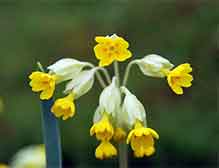 April can bring many joys in the countryside and one of those is certainly the flowering of cowslips. We are fortunate to have cowslips growing in some abundance in Compton Bassett, mostly up on the downs, although as with much of the flora to be found there, the plants have adapted themselves to the thin chalky soils and are small and delicate and with very short stems. Please, please don‘t pick them, they need all the protection that they can get. In Victorian times children used to make cowslip balls or ’tossies‘ tying great bunches of the flowers tightly together just below the heads. And cowslip wine was a firm favorite.
April can bring many joys in the countryside and one of those is certainly the flowering of cowslips. We are fortunate to have cowslips growing in some abundance in Compton Bassett, mostly up on the downs, although as with much of the flora to be found there, the plants have adapted themselves to the thin chalky soils and are small and delicate and with very short stems. Please, please don‘t pick them, they need all the protection that they can get. In Victorian times children used to make cowslip balls or ’tossies‘ tying great bunches of the flowers tightly together just below the heads. And cowslip wine was a firm favorite.
In a cowslip‘s bell I lie‘
The Tempest JSR
March 2013
Country people look forward to the arrival of the barn swallows. Last year Peter Barnett saw his first one on Sunday 15th April. What amazing little birds they are, flying from Cape Town they can migrate to Britain in 27 days given the right conditions. It is possible for them to fly 300 kilometres in a day.
The Sparrow has found her a home
And the Swallow a nest, where she may lay her young. Ps. 84 v 3.
Some Summer Thoughts on Swallows
June 2012 - The return of our swallows and house martins was a bit “touch and go” this season but in the end we have seen more of these welcome visitors than for many years in the past. Their hectic energy seems to add an impetus to the Summer which would be sadly lacking without them. They duly arrived on about their usual dates in April and early May and we enjoyed the thrill of their return; that feeling that all must be well with the world if this annual miracle can still take place. But, as has happened so often before, the day after their return we looked to an empty sky and saw them no more. A full two weeks passed before their return and then they frantically set about nest repairs and all manner of domestic tasks. Where do they go in this interval and what do they do? Are they waiting for more hatches of flies to secure their food supply before nesting can start? Or perhaps they have congregated in a place where there are easy pickings in order to build up their energy supply after their long flight home. Has anybody else noticed this phenomenon or got any ideas about what might be the reason for it?
JSR
And the Swallow a nest, where she may lay her young. Ps. 84 v 3.
Some Summer Thoughts on Swallows
The Geology and Archaeology of Compton Bassett
Compton Bassett is known principally for two areas of geology. The chalkstone on the upper areas of Roach and the Marlborough Downs and the sand and gravel which is extracted and backfilled with landfill to the east of Calne.
The chalkstone has been used as the building material for much of the older dwellings of the parish and has created the picture postcard images of white stone cottages the the village has bercome famed for.
Prehistoric remains
Crop Circles
from around the county
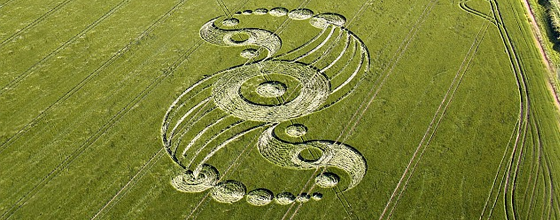 g Compton Bassett in particular. Although Compton Bassett has never had a circle within it's boundary, it is surrounded by sites of special crop circle interest. Until recently the Silent Circle crop circle information centre was based in The White Horse Inn within the village, although this year it is based in our neighbouring village of Yatesbury. The Wiltshire Crop Circle Study Group are also based in nearby Devizes and both would be happy to help you understand the circles.
g Compton Bassett in particular. Although Compton Bassett has never had a circle within it's boundary, it is surrounded by sites of special crop circle interest. Until recently the Silent Circle crop circle information centre was based in The White Horse Inn within the village, although this year it is based in our neighbouring village of Yatesbury. The Wiltshire Crop Circle Study Group are also based in nearby Devizes and both would be happy to help you understand the circles.
- Crop circles exist the world over
- Since 1980 over 6,000 have been documented
- They are some incredibly beautiful and complex works of art
- They are usually mathmatically perfect in their layout and design
- Their designs are often based on ancient mystical symbology
- There is much scientific research which offers many reasons why the sceptical should look at them in a different way
- There is much scientific research which offers many reasons why the believer should look at them in a different way
- Many derive spiritual benefit from the messages that they believe can be decoded from the patterns and layouts
- Some are created by the mischievous and fool the willing believer
- They are all created on someone's land
- They are all created in a commercial crop
- To visit them without permission from the landowner is trespass
- Visiting them, without care for the crop they are in, will impinge on someone's ability to make a living, on their ability to put food on their family's table and ultimately, on your table